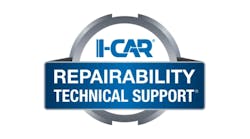South of Denver, in the inner-ring suburb of Englewood, there’s a family-owned body shop that’s getting leaner all the time. Hampden Auto Body owner Mike Ross and his staff have embraced a new way of doing business that has led to faster cycle time, more dollars per day and more efficient repair processes.
Ross’s father, Dan, started the shop in 1983. The shop was only 8,000 square feet, which meant using every inch as productively as possible. “My father was lean, before lean,” Ross explains. Today, the shop is still 8,000 square feet, and it’s still independently owned, although it joined Fix Auto—a network of independently owned repair facilities—in 2006.
Mike Ross took over the shop from his father in 1998. Although the shop was efficient, he saw there was still room for improvement. With general manager Brian Tokle, he figured out how to churn out more repairs without compromising the quality that earned Hampden its reputation. Ross has a hard time explaining what’s changed because, essentially, he says, “Everything has changed.”
Tracking Everything
Hampden earns $160,000 to $200,000 in monthly sales, repairs 60 to 100 cars each month, and employs 10 people. The shop has two frame machines, a paint booth, a spot welder and four MIG welders. The first step in managing those resources efficiently was to install management software. That let Ross track every key performance indicator: how long it takes each car to get through each repair stage, daily production hours and many other metrics.
In 2007, when Ross began tracking these numbers, overall sales in dollars per day averaged about $350 per repair order. Today, it’s between $450 and $500. Daily touch time, which was about three-and-a-half-hours in 2007, now hovers around five. That has reduced cycle time significantly; for heavy structural hits, jobs that once took 12 days now take seven because techs are spending more time actually working on cars each day. Some smaller jobs, like bumper repairs, are down from three days to less than one.
“The lean process really affects those touch-time, cycle-time and dollars-per-day metrics the most,” Tokle says. “As we’ve improved those, it’s correlated with better customer service numbers, because we’re hitting 100 percent ready-when-promised and getting cars back to our customers two or three days ahead of schedule.”
“Why” First, Then “What”
The shop’s new “meticulous discovery” process has contributed greatly to those improved metrics. It amounts to asking “why”—a lot. “We say that we ask ‘why’ five times before we finalize a procedure,” Ross says.
–Mike Ross, owner of Hampden Auto Body
That means that at Hampden, they take more time to carefully go over every inch of the vehicle and determine everything that needs to be repaired and all the parts needed to repair it. It’s worth it to Ross, because the extra time on the front end means less time on the back end. “It takes time and patience, but to get it right, you have to look into everything,” Ross explains. “If a car doesn’t start and we had to tow it, why? Is it the battery? Is the gearbox knocked loose? It could be many things, and we discover it all in the discovery process.”
Meticulous discovery keeps vehicles on schedule and protects the shop from supplements. After doing a minor study with data from the management system, Ross says, he found that the average supplement costs the shop $700 between paperwork, lost time, approvals, and the possibility of jeopardizing relationships with customers and insurance companies.
The same question applies when something goes wrong: Why? If a car is scheduled to go out on Friday and it isn’t ready, they investigate until they discover the root cause of what went wrong. “The procedure is to find out everything you need up front, so that you don’t hold up the final delivery with a belt molding or a clip you forgot,” Ross says. “So we ask, ‘Why didn’t the car go out as scheduled? Because I didn’t have a clip I needed. Why didn’t you have the clip? Because I didn’t go over the car well enough when I was writing the final bill. Why didn’t you go over the car well enough? Because I didn’t have a process to do that.’ It’s using the problems and challenges that present themselves to teach us how to do better next time.”
The Most Direct Route
A common step in going lean is to remove unnecessary items from the workplace. But Tokle and Ross realized that there was an intangible clutter that could also be eliminated: unnecessary steps.
“We counted footsteps for different types of errands, and it’s amazing how many miles you can travel in an 8,000-square-foot facility,” Ross says. For example, techs used to visit inventory several times a day for materials or tools. Now, each tech has his own wheeled cart that holds the tools and materials he uses all day, so that he doesn’t ever have to take unnecessary steps to get them.
Specifically, the disassembly tech’s cart has appropriate tools for disassembly and an assortment of the clips he typically removes and replaces, while the painter has the grade of sandpaper he uses—and the body techs have their own grade. The carts are restocked at the end of the day.
“We get new ideas every day to minimize the number of steps the production people have to take,” Ross says. “The more we work on the vehicle, the more profitable it is.”
A similar re-engineering took place in the paint booth. In the past, the entire car went into the paint booth, no matter what was being painted. When replacing a door, for instance, it was cut in and hung on the car. Then the car went into the booth to blend the door with the fender. But that allowed only one job in the booth at a time.
Now, Ross says, “We paint multiple repair orders in the booth at the same time by taking parts off the vehicle.” At any given time, there might be parts from six different jobs in the booth: four bumpers, a hood, and a fender and door.
The new process means that the repair plan has to be very tight in discovery. With each repair plan, the parts that need to be repainted are spelled out, and decisions are made on whether those parts can be removed and sent through the booth while the rest of the car stays put.
Buy-in Comes First
Tokle and Ross didn’t make the mistake of starting their lean journey by mandating it from on high. “We knew we had to create an environment for change,” Ross explains. “If your staff doesn’t understand why you’re changing your processes, they’ll battle you on it.”
So the duo gathered the staff and presented the state of the collision repair industry: profits are shrinking while costs for everything from materials to health care are going up. In that environment, the shop had to get more efficient—and everybody needed to help figure out how.
“Going lean requires a lot of leadership,” Ross says. “You have to lead them to where you want them to go, and get their buy-in so they want to go too.”
In fact, one of Ross’s employees presented an idea that Ross had been hoping to implement. The body technicians and their helpers work on commission, and Ross had divided the work among them. To distribute the work fairly, he occasionally had to hold up jobs.
Then the lead technician said it would make more sense for all of them to work as a team. Now, the three are responsible for every job that comes through the shop. Not only does Ross no longer have to hold up jobs, the three have divided responsibilities more efficiently than before. The tech who is good at remove-and-install does the disassembly and discovery process, while another tech specializes in structural work.
Applause
The changes have led to happier customers and industry kudos. For two years now, Hampden has won Best of the Best awards—in the auto body or paint shop category—from Colorado Community Newspapers.
Hampden’s internal numbers, meanwhile, earned the Fix Auto Network’s “most improved shop” award last year in the Fix Auto Annual Awards. “We collect data from all the shops in our network for metrics like cycle time, dollars per day, and customer service,” says Fix Auto CEO Erick Bickett. “We rank all our shops in quadrants—the top 25 percent, the top 50 percent and so on—and Hampden went from the 50th percentile to the 25th on several of those performance categories.”
Bickett says he was pleased to see Hampden win. “I’ve met the entire staff at Hampden and they’re very consistent in wanting to improve and excel,” he says. “You have to have people with that attitude to make lean work, and [at Hampden] they’re wide open to whatever is necessary to drive performance and improvement.”
Tokle encourages owners to try—and keep working on—ongoing, continuous improvement. “It’s not going to happen overnight. You have to change the culture and then think this way for the rest of your career,” he says. “You can’t give up, because that means going back to the same old habits—and the same old headaches. It’s an endless path, but you do see the fruits of your labor.”



